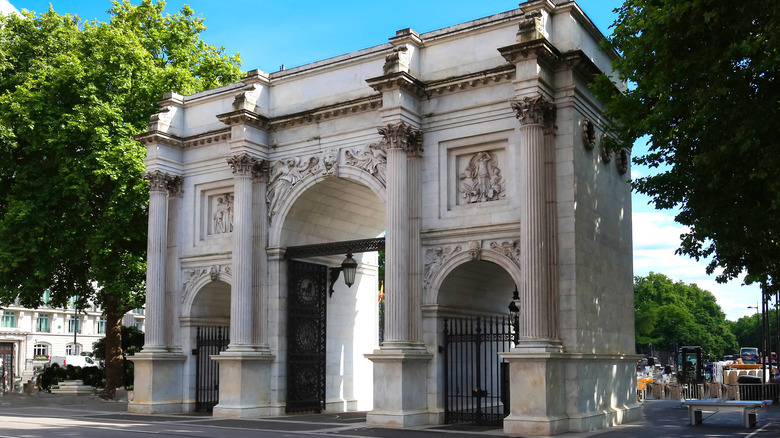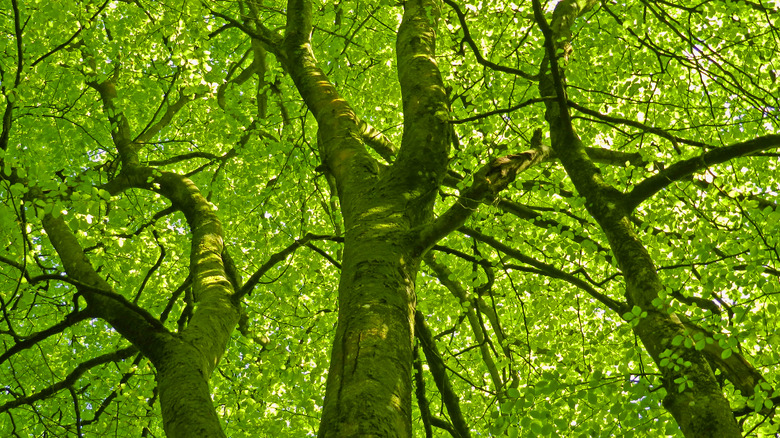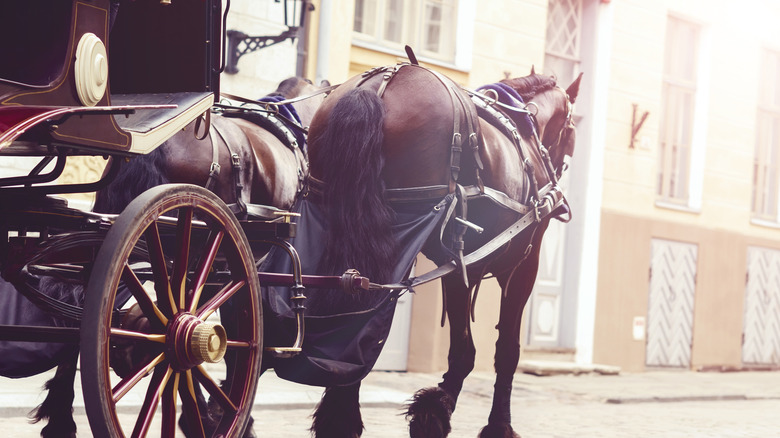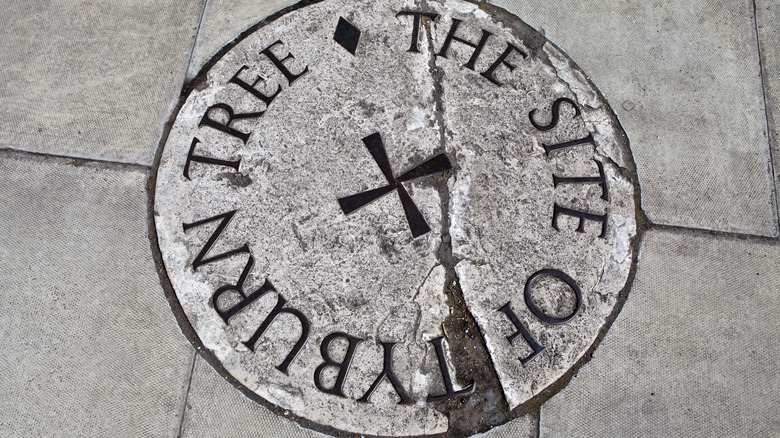Behind The Executions That Took Place At What Is Now England's Marble Arch
If you visit the Marble Arch in London, England today, you can walk through a white arch covered in military friezes and intricate carvings, per Marble Arch London. Located near Hyde Park, it's a major landmark that draws in visitors and locals alike. But what you won't see is the history behind the monument — namely, the hundreds of people who were executed there and whose remains still lay buried under the site.
According to Look Up London, the first public hanging at Tyburn Tree took place in 1196. Interestingly, the name is misleading, as there is no specific Tyburn Tree — condemned people were originally hung along a row of elm trees overlooking Tyburn Brook, History reports. The actual Tyburn Tree was established later on (and it was also not a tree, but more on that later). Thousands of people would gather to watch the convicted dance the "Tyburn jig," as it was morbidly referred to (via Atlas Obscura).
The 'Deadly Never Green Tyburn Tree'
Per Atlas Obscura, the site was given several ominous nicknames like "the Deadly Never Green Tyburn Tree" and "the Triple Tree." Today, only a tiny plaque embedded in the surrounding street commemorates the many hundreds of lives lost (via Look Up London).
Criminals were held at London's Newgate Prison until they could be hanged (via Marble Arch London). Over hundreds of years, History reports, criminals were hanged for all sorts of offenses, ranging from murder to robbery to traitorous acts. During the Reformation era, at least 350 Catholics who refused to renounce their faith also died at Tyburn Tree.
Hangings were an extremely popular form of entertainment, so much so that in the 1500s, the executioners at Tyburn created gallows that could hang three people at the same time (via Look Up London). Later on, the gallows were expanded even more so crowds could see 24 people hanged at one time (via History). This is the real Tyburn "tree" — a humongous triangular gallows made for mass executions.
One last drink
Executions were held on Mondays, and prisoners were allowed to dress in their best outfits (via History). It was a momentous occasion for the average person; people were given time off from work to attend, and it was treated as a holiday, so everyone wanted to be a part of the festivities (via My London). And due to the large number of people crowding the streets for the execution, the normally brief trip to the Tyburn Tree could take as long as three hours for the well-dressed prisoners inside the prison wagon (via Marble Arch London).
History reports prisoners were actually allowed to hop off the wagon and have one last mug of ale while on their way to the execution. After guzzling their final alcoholic beverage, the prisoners would have to climb "back on the wagon," which may have coined the current phrase for a person who has abstained from drinking forever.
Final words
People loved the dramatic flair of the executions. Per Atlas Obscura, prisoners usually had a lot to say in their final moments. Some would speak truth to power or reveal political opinions, while others would swear their innocence or come clean about their crimes with a final confession (via Look Up London). And Marble Arch London reports that executions were actually supported by local officials, who believed that public hangings would deter other people from committing crimes in the first place.
Per History, when all was said and done, the condemned would be put atop a horse-drawn carriage with nooses wrapped around their necks. The wagon would speed away, resulting in their immediate hanging. To speed up the process, sometimes the friends and family of the criminal would rush forward and pull on their feet so that they would perish faster and avoid suffering.
Criminals were killed in very brutal ways, depending on the severity of their crime. For example, William Fitz Osbert, who started a revolt in the 1100s, was tied to a horse and dragged naked through the streets (via MyLondon). He was hanged once the horse delivered him to the gallows.
People clamored for the best views
One of the most well-attended executions ever was for Jack Sheppard, a notorious highwayman (a thief who patrols the roads and robs drivers at gunpoint, per Merriam-Webster). According to Look Up London, more than 200,000 people packed the streets to see Sheppard's final moments.
For those who didn't want to stand amongst the hoi polloi, History reports that people paid to sit in special galleries that were only constructed for the executions. Other people would rent out the top floors of local bars or houses to get a good view. After the deceased was cut from the gallows, the excited viewers would surge from their seats. They would compete to grab at the remains of the executed person because these body parts were supposedly used to heal various illnesses or diseases. Even doctors joined in so they could scavenge fresh cadavers to practice dissections on. After that, lots of the bodies were simply buried right there beneath the gallows.
What remains of Tyburn Tree
Despite the uproar they caused, the hangings didn't seem to deter crime that much because people often got pick-pocketed while squeezed into tight crowds, according to Marble Arch London.
After nearly 600 years of executions at Tyburn, the last ones were held in 1783 (via History). As the area surrounding Tyburn was becoming posher, executions were moved to Newgate Prison. Look Up London reports that the Marble Arch was originally built outside of Buckingham Palace. It was then reconstructed near Hyde Park in 1851 and remains a popular tourist destination.
If you visit the Marble Arch today, you can still see remnants of executions past. Take a walk to Speaker's Corner — named after the prisoners who spoke their last words — where folks now hold public speaking sessions. And if you look between three trees nearby, you'll find the round plaque in the cement that reminds us of the gruesome history behind the Tyburn Tree.





